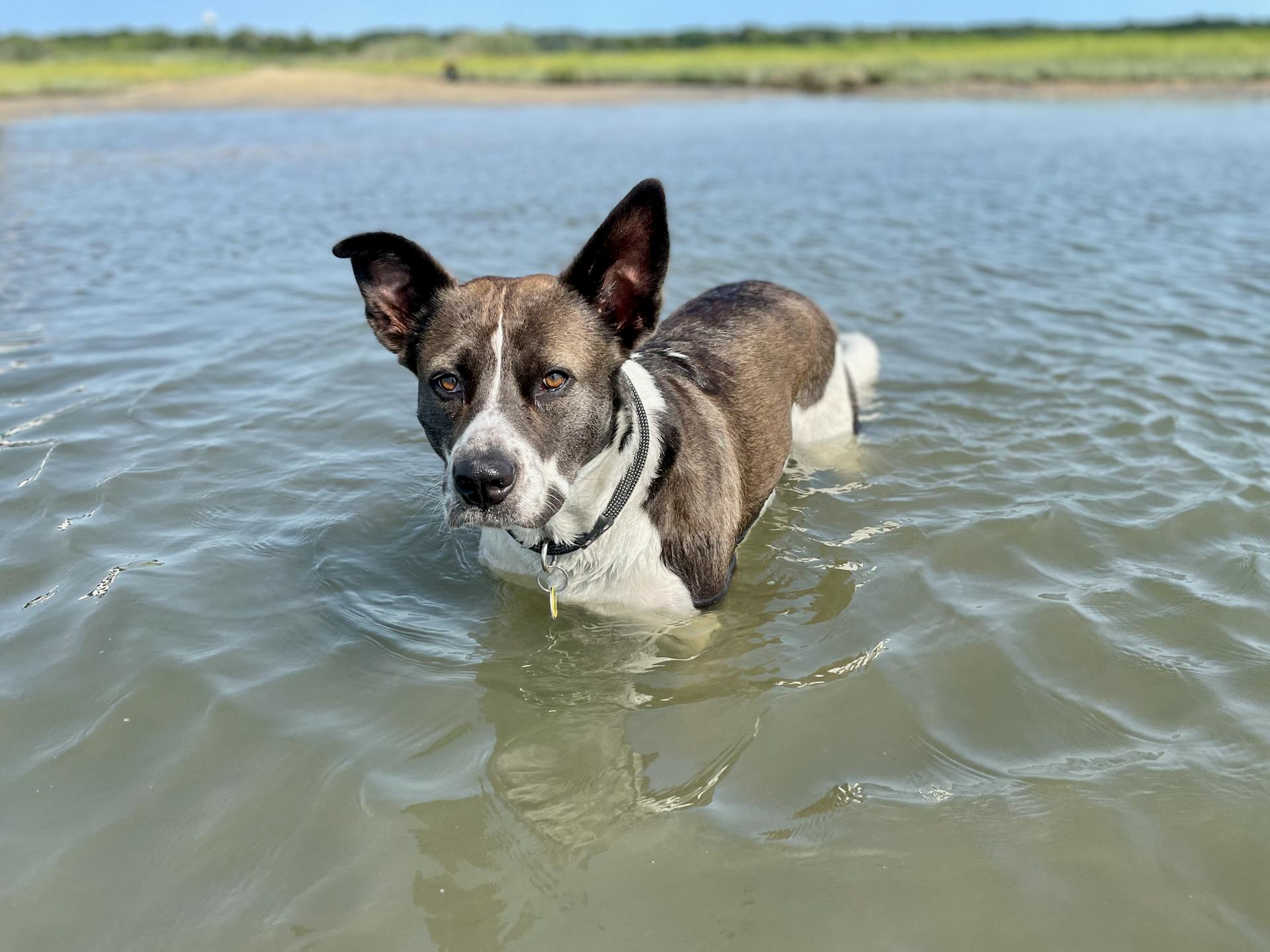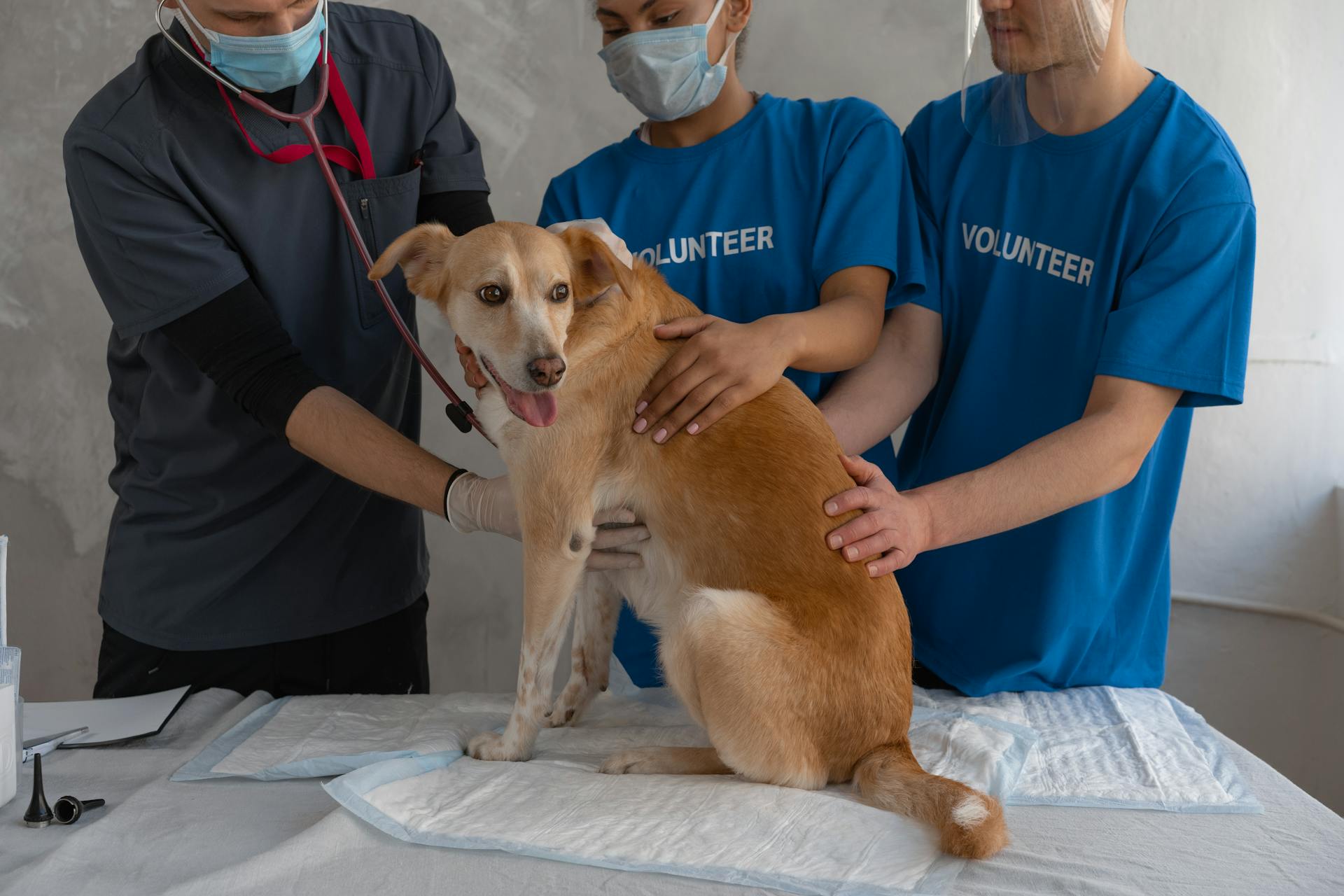
Canine influenza, also known as dog flu, is a highly contagious respiratory disease that affects dogs.
The canine influenza virus, identified as H3N2, is a mutated strain of the flu virus that affects dogs specifically.
Dogs can get infected with canine influenza through direct contact with an infected dog's respiratory secretions, such as through touching or kissing.
It's essential to note that canine influenza is not the same as the flu that affects humans.
Symptoms of canine influenza can range from mild to severe and may include a runny nose, coughing, sneezing, and a decrease in appetite.
Related reading: Canine Distemper Infection
What Is Canine Influenza?
Canine influenza is a contagious respiratory disease that affects dogs. It's caused by a virus, specifically the H3N8 or H3N2 strains.
The virus is highly contagious and can spread quickly among dogs, especially in areas with high dog population density. This is because dogs can become infected by coming into contact with the virus through respiratory droplets, contaminated food and water bowls, and even by touching surfaces that have the virus on them.
Discover more: How Contagious Is Kennel Cough
Symptoms of canine influenza can vary, but they often include a runny nose, cough, and fever. Some dogs may also experience lethargy, loss of appetite, and difficulty breathing.
The virus has two main strains: H3N8 and H3N2. The H3N8 strain was first identified in the United States in 2004, while the H3N2 strain was first detected in South Korea in 2010 and later introduced to the United States in 2015.
Canine influenza can be severe, especially in dogs with pre-existing medical conditions or weakened immune systems. In some cases, the virus can lead to secondary bacterial infections, which can be life-threatening if left untreated.
On a similar theme: New Kennel Cough Strain 2023
Transmission
Canine influenza is a highly contagious disease that can spread quickly among dogs. Infected dogs can be contagious even if they don't seem ill, and they can spread the virus for up to four weeks after they were first exposed to it.
The virus is mainly spread through respiratory droplets, which are released when dogs cough, sneeze, or bark. Direct contact, such as when dogs lick or nuzzle each other, also plays a significant role in the transmission of the virus.
Intriguing read: Contagious Dog Diseases
Infected dogs can spread the virus through contaminated objects like food and water bowls, toys, and kennel surfaces. Skin and clothing of people who have been in contact with infected dogs can also carry the virus.
The virus can survive on surfaces for up to 48 hours, on clothing for 24 hours, and on hands for 12 hours. This means that rigorous biosecurity and disinfection practices are crucial in reducing the risk of disease transmission.
Here are the main routes of exposure:
- Direct contact, as when dogs lick or nuzzle each other
- Coughing, sneezing, and barking
- Contaminated objects like food and water bowls, toys, kennel surfaces, or clothing
- Skin and clothing of people who have been in contact with infected dogs
In areas experiencing an outbreak, dogs at particular risk include those that are boarded and/or mix with other dogs at dog daycare, dog parks, dog shows, and agility events, as well as dogs that travel.
Diagnosis and Testing
Diagnosis and testing for canine influenza can be a bit tricky, as the symptoms can resemble those of other respiratory infections. Your veterinarian will likely suspect canine influenza based on your dog's history and lifestyle, as well as whether the virus is known to be circulating in your area.
Recommended read: Canine Flu vs Kennel Cough
A nasal swab or blood sample may be collected to confirm the diagnosis. Specific laboratory tests are needed to confirm canine influenza virus infection.
The most reliable way to confirm canine influenza virus infection is through serologic testing, which involves comparing antibody levels two to three weeks apart. However, this test requires two serum samples, which can be a bit of a challenge.
If the PCR test is positive, the dog most likely has CIV. However, after four days of illness, PCR results are less likely to be accurate, and false-negative results may occur.
Here are the common testing options for canine influenza:
- Polymerase chain reaction (PCR) testing for virus nucleic acid
- Serologic testing for antibodies against the virus
- Virus isolation
- Immunoassays to detect virus antigen
It's essential to note that the type of test used will depend on the stage of the illness and the veterinarian's discretion.
What Are the Signs of?
The signs of canine influenza are quite similar to those of kennel cough, which can make it tricky to diagnose.
A persistent cough is the most common sign, lasting anywhere from 10 to 21 days. Thick nasal discharge is another common symptom, along with fever, often ranging from 104-105F. Some dogs may also experience lethargy, runny eyes, and reduced appetite.
Consider reading: Most Common Dog Diseases
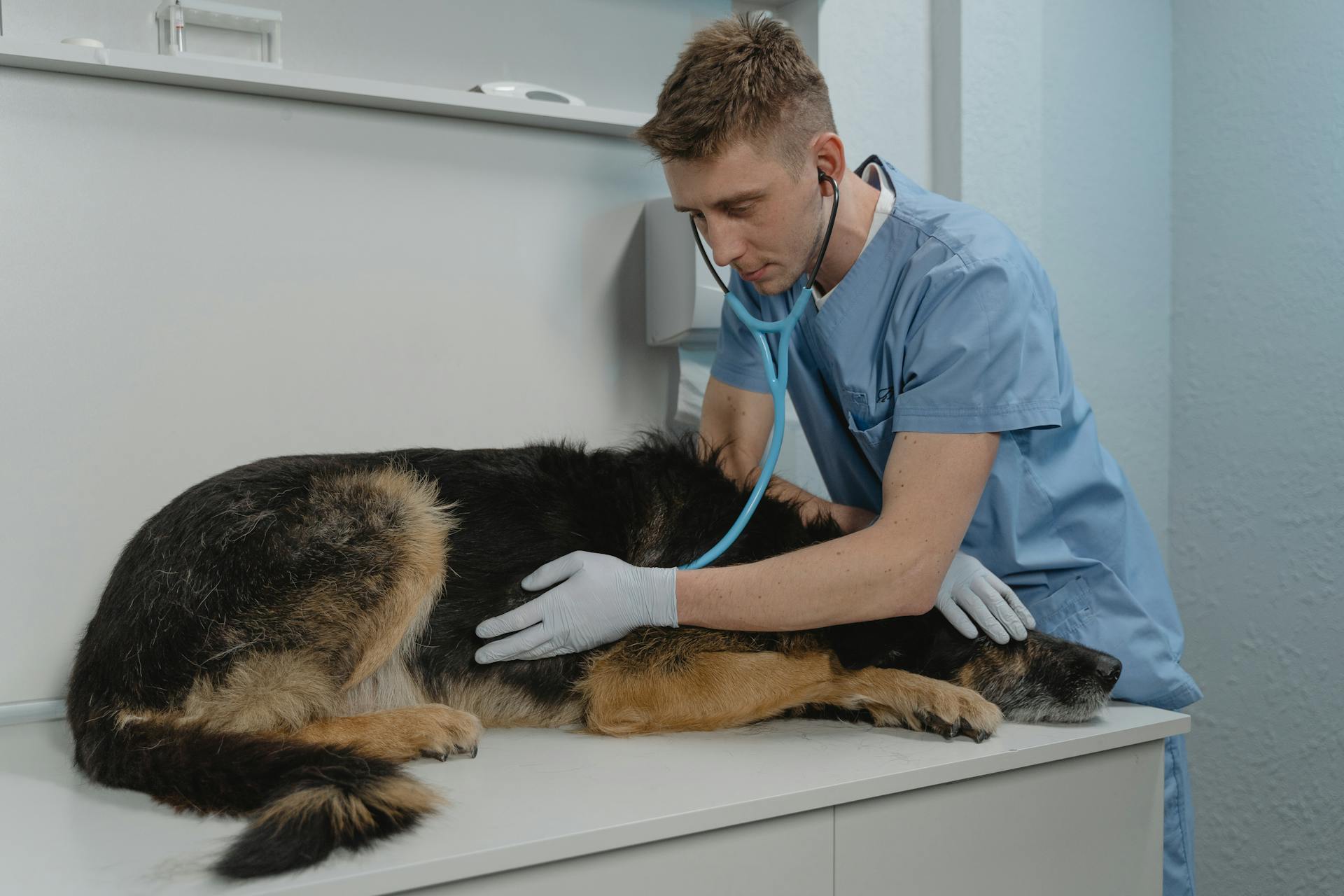
If your dog is showing any of these symptoms, it's essential to contact your veterinarian right away. You should also inform any training, daycare, or kennel facility your dog has recently visited to prevent the virus from spreading.
Here are the common signs of canine influenza:
- Persistent cough
- Thick nasal discharge
- Fever (often 104-105F)
- Lethargy
- Runny eyes
- Reduced appetite
Older dogs and those with heart or respiratory conditions are at a higher risk for developing canine influenza. Brachycephalic breeds, such as Boston Terriers and Pugs, are also more susceptible to the virus.
Diagnostics
Your veterinarian may suspect canine influenza based on your dog's history and lifestyle, as well as the presence of the virus in your area.
Specific laboratory tests are needed to confirm a diagnosis of canine influenza, which can be tricky because the symptoms resemble other infectious respiratory illnesses.
These tests may involve collecting nasal or pharyngeal swabs, blood samples, or other specimens for analysis.
Polymerase chain reaction (PCR) testing for virus nucleic acid is a common diagnostic tool for canine influenza.
Serologic testing for antibodies against the virus is considered the most reliable way to confirm infection, but it requires two serum samples, one when the dog first presents and another two to three weeks later.
A nasal swab for a PCR test can be submitted to a veterinary laboratory if a dog is seen within the first few days of the onset of clinical signs.
After four days of illness, PCR results are less likely to be accurate, and blood testing for CIV antibodies should be performed.
Here are some common diagnostic tests for canine influenza:
- Polymerase chain reaction (PCR) testing for virus nucleic acid
- Serologic testing for antibodies against the virus
- Virus isolation
- Immunoassays to detect virus antigen
It's essential to note that PCR testing may detect other influenza viruses, which can be useful for ruling out other causes of infection.
Treatment and Prevention
Treatment for canine influenza is largely supportive, designed to provide rest, fluids, and nutritional care to keep the dog comfortable. In severe cases, antibiotics may be recommended to combat secondary bacterial infections or pneumonia.
Dogs with mild cases of canine influenza will often recover within two to three weeks, but it's essential to keep them isolated for at least 21 days to prevent further spread of the virus. This means keeping them at least 20 feet away from other dogs and cats, and thoroughly cleaning and disinfecting areas where they've been examined and treated.
A bivalent vaccine offering protection against both H3N8 and H3N2 canine influenza is available, and may provide broader immunity. Vaccination is particularly recommended in areas where the virus is known to be circulating, especially for dogs that are boarded or exposed to other dogs through activities or places where dogs congregate.
Dogs that travel may also benefit from vaccination, and initial vaccination can begin as early as six weeks of age. The recommended protocol is two doses two to four weeks apart, with revaccination within one year after the second dose, and subsequent boosters given annually.
How to Prevent Spread
Preventing the spread of canine influenza is crucial to keeping your furry friend healthy. Keep in mind that infected dogs can be contagious even if they don’t seem ill, and they can spread the virus for up to four weeks after they were first exposed to it.
To reduce the risk of transmission, keep known or potentially infected dogs at least 20 feet away from other dogs and cats. This simple step can go a long way in preventing the spread of the virus.
In addition to physical distance, it's essential to prevent direct contact between dogs. This means avoiding dog daycare, dog parks, dog shows, and agility events, especially during an outbreak. You can also reduce the risk of transmission by thoroughly cleaning and disinfecting areas where potentially infected dogs are examined and treated.
Here are some essential steps to take when dealing with a potentially infected dog:
- Keep the dog isolated in a room with a separate air supply
- Wear personal protective equipment (PPE) when examining or caring for the dog
- Practice hand hygiene to prevent the spread of the virus
- Refrain from hospitalizing dogs with non-critical health concerns to prevent exposure to other animals
By following these simple steps, you can help prevent the spread of canine influenza and keep your furry friend safe.
Treatment and Prevention
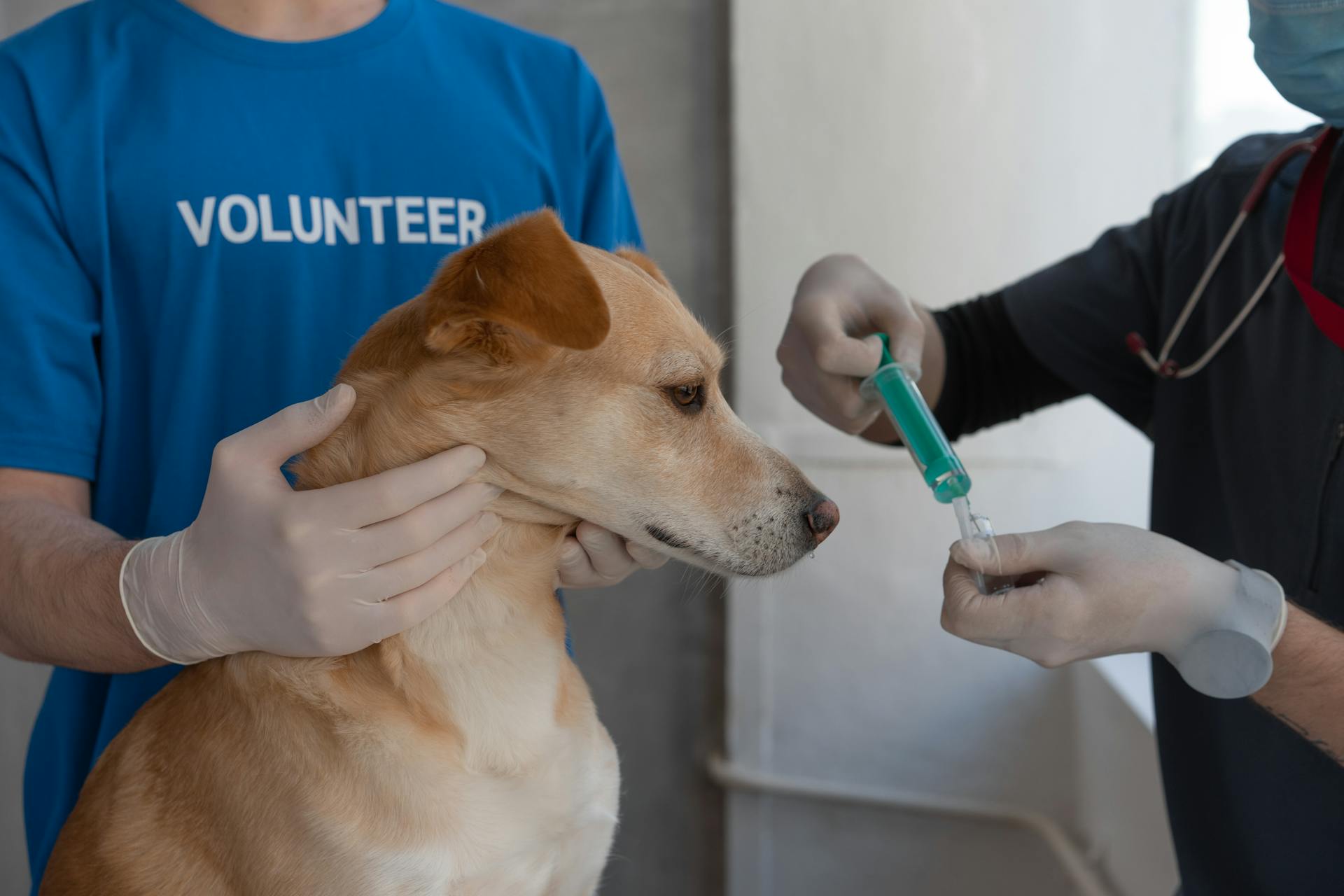
Treatment for canine influenza is largely supportive, designed to provide rest, fluids, and nutritional care to keep the dog comfortable. In severe cases, antibiotics may be recommended to combat secondary bacterial infections or pneumonia.
Supportive care can include fluids to manage dehydration, nutritional supplementation, and nonsteroidal anti-inflammatory medications to reduce fever and inflammation. Good nutrition and husbandry are crucial in ensuring that dogs mount an adequate immune response to help promote faster recovery.
Dogs with respiratory infection need to be kept isolated from other dogs to prevent disease from spreading. The recommended isolation period for dogs with canine influenza is four weeks after signs first appeared, or at least 21 days for dogs with H3N2 canine influenza and seven days for dogs with H3N8 canine influenza.
A vaccine is available for canine influenza, and it's licensed by the US Department of Agriculture. The vaccine is a killed adjuvanted product, and yearly vaccinations are recommended in settings where there is a defined risk for influenza virus infections.
Take a look at this: Canine Coronavirus Vaccine
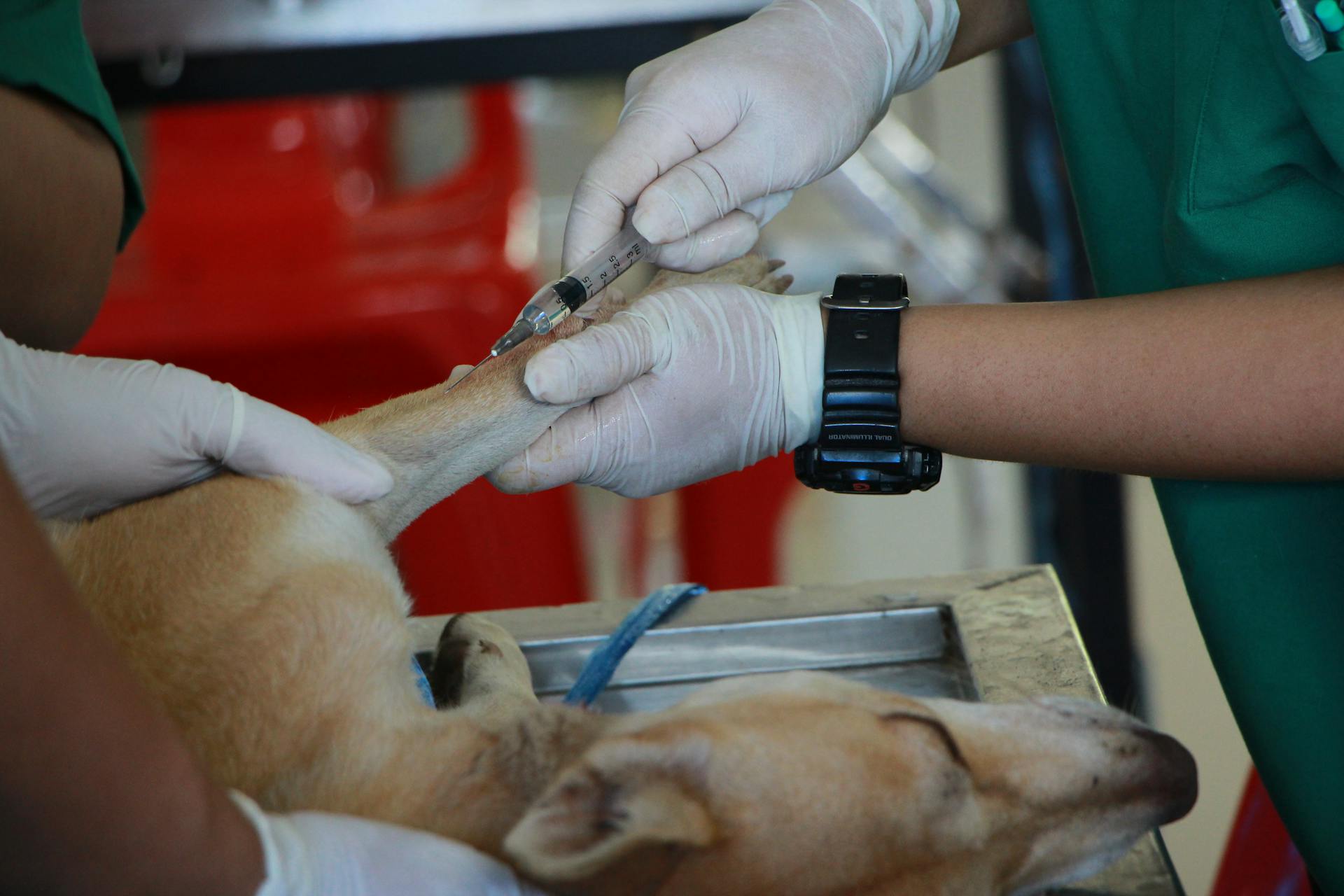
Here are some general guidelines for preventing the spread of canine influenza:
- Keep known or potentially infected dogs at least 20 feet away from other dogs and cats.
- Have the dogs enter and exit the hospital through a separate door, and take them to a room where they won’t be exposed to other animals.
- Wear personal protective equipment (e.g., gowns, booties, and disposable gloves) when examining or caring for the dogs.
- Thoroughly clean and disinfect areas where potentially infected dogs are examined and treated.
Note that vaccines will not necessarily prevent infection, but they can substantially reduce severity and duration of illness, as well as viral shedding.
Protecting Your Dog
Vaccination is not always necessary, but it's recommended if your dog is at risk of exposure. Talk to your veterinarian about your dog's risk and whether a vaccine is right for them.
Keep your dog away from other dogs if they're coughing or sneezing, and call your vet for advice before taking them in.
Reducing contact with large numbers of unknown dogs can help prevent the spread of canine influenza.
Watch for local alerts and keep your dog away from places where dogs gather if there's an outbreak in your area.
Wash your hands after handling any dog, especially a sick one.
Sharing your dog's bowls, toys, and other items with other dogs outside the home can spread the disease, so avoid it.
A unique perspective: How Often Does a Dog Cough with Kennel Cough
If you're planning to board your dog or take them to dog shows or training classes, ask about the facility's infection control measures and whether respiratory disease has been a problem there.
A good rule of thumb is to ask about the facility's plan for isolating dogs with respiratory disease and notifying owners if their dogs have been exposed to infectious disease.
Check this out: Respiratory Allergies in Dogs
Frequently Asked Questions
Are Bordetella and canine influenza the same?
No, Bordetella and canine influenza are not the same. They are two distinct viral infections that affect dogs, with canine influenza caused by two specific strains: H3N8 and H3N2.
How long does canine influenza last in dogs?
Canine influenza typically lasts 2-3 weeks in dogs, but isolation for 4 weeks is crucial to prevent further spread. Consult with your veterinarian for guidance on treatment and recovery.
Sources
- https://www.avma.org/resources-tools/pet-owners/petcare/canine-influenza
- https://www.avma.org/resources-tools/animal-health-and-welfare/animal-health/canine-influenza-veterinary-resources
- https://vcahospitals.com/know-your-pet/canine-influenza-the-dog-flu
- https://en.wikipedia.org/wiki/Canine_influenza
- https://www.ncbi.nlm.nih.gov/pmc/articles/PMC7132494/
Featured Images: pexels.com


